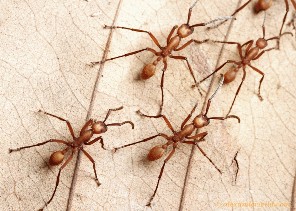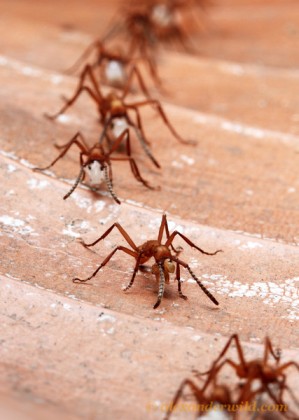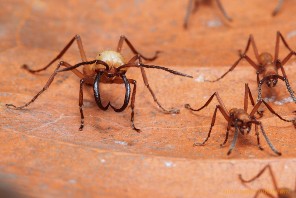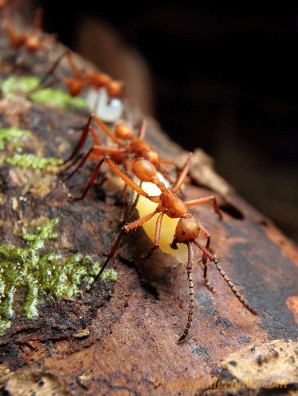Reproduction
Life and Nomadic
Cycles of Army Ants
Army Ants reproductive life cycle starts with the queen of the
colony laying a sexual or asexual crop of eggs. When the queen
lays her eggs, she marks the beginning of the beginning of the
stationary phase. These eggs are carefully taken care of by
young worker ants since the development of the eggs is very
delicate. The workers move each of the eggs to the middle of the
bivouac where they remain until they hatch. After the eggs
hatch, the new larvae are now the brood of the colony and the
hatching of the eggs signals the start of the nomadic nights for
the colony. This nomadic condition is induced to support the
need for a high fat diet needed for the brood to properly
develop. The worker ants now take care of the new brood as they
would with the eggs, but the new brood also requires food. These
larvae require a lot of care since are unable to move because
they lack legs and have a small mouth that is incapable of
chewing food. To feed the brood the worker ants must chew the
food themselves and then regurgitate it so they can feed the
brood by mouth to mouth; this method of feeding is called trophallaxis. Adult ants also use this method to share food
amongst themselves, click
here to
find out more about the nutrition of an ant. In addition,
workers will moderate the temperature for the brood by taking
them to different parts of the bivouac at different times of the
day to favor development. After the larva grow to maturity and
transition into pupae they begin to undergo a metamorphosis into
adult ants. At this point the ants transition back to the
colonies stationary condition, the queen lays another batch of
eggs, and the cocoons containing pupae are in are moved to the
outer edges of the bivouac to metamorphose. Once the
metamorphosis is complete and the ants begin to eclose, emerge
from their cocoons, the new adults help other members within
their cocoons emerge as well. As the new members are emerging
the new eggs begin to hatch into larvae and the nomadic
condition is begun again. Check out another organism with a
complex life cycle the fungus
Amanita phalloides (The death cap).
Broods
Most broods are produced by queen ants through parthenogenesis,
the development of eggs without fertilization, is typically what
the queen ant does when laying eggs for the next generation of
ants. The offspring of these asexual broods consist purely of
females because the genetic material required for a male is not
in her body. These females from the asexual brood will all
mature into new workers for the colony. However, sexual broods
are laid from time to time when the queen is inseminated by a
male of another colony. When this happens the queen lays a brood
with both male and female offspring. To ensure the queen has the
ability to produce more sexual broods in the absence of another
male the queen is able to store the sperm from the previous male
in a special organ. The new generation typically contains
approximately 1500 males out of the typical 80,000 offspring
which grow up quite differently from the other females. These
males are much more developed than their female counterparts and
each male larvae may consume up to 50 times more food than their
females counterparts. These males become a large stress on the
colony because of their huge size and appetite. During their
growth the colony does not begin its regular nomadic phase
because the male larvae is to large to be carried. In addition,
during the sexual broods lifespan the colony itself is in a
hunting frenzy to try and met the enormous needs of the large
males. Throughout the males lives they do not contribute to the
colonies maintenance functions and are eventually forced out of
the colony to search for a queen with which to mate.
Finding a Mate
Upon leaving the colony the male army ants use their wings to
search for a colony of the same species. This journey is
extremely dangerous for the males who are alone and possess very
weak mandibles. However, these males do possess strong eyes to
search out ants of the same species with which to mate. Once the
male finds another colony of Eciton hamatum army ants
the male must be accepted into the colony before he can mate
with the queen. The worker ants of the new colony must accept
this new male into the colony to mate with their queen. The
workers select for a male that closely resembles their own queen
and thus let the new ant into the colony. This mimicry grants
the male access to the queen and is finally able to mate. Mating
for the male though is lethal, since the organ which contains
the sperm cells bursts inside the queen and results in the death
of the ant within the next 48 hours.
New Queens
 In a sexual brood, females that are given a plentiful food
supply for maximum nutrition will reach sexual maturity
resulting in the formation of a new queen. Workers that take
care of the queen, in the parent colony, through out its
development bond with the queen through chemical scents and will
eventually leave with her. When the new queen is ready she will
leave the parent colony with her workers to form a satellite
colony of her own. For up to a week workers from the parent
colony and the satellite colony will travel back and forth
between the two. After the new colony increases in size and
numbers the new colony will not recognize the parent colony and
the two may fight if the colonies cross paths.
In a sexual brood, females that are given a plentiful food
supply for maximum nutrition will reach sexual maturity
resulting in the formation of a new queen. Workers that take
care of the queen, in the parent colony, through out its
development bond with the queen through chemical scents and will
eventually leave with her. When the new queen is ready she will
leave the parent colony with her workers to form a satellite
colony of her own. For up to a week workers from the parent
colony and the satellite colony will travel back and forth
between the two. After the new colony increases in size and
numbers the new colony will not recognize the parent colony and
the two may fight if the colonies cross paths.
In the case a new queen in the presence of an old queen the
young queen will not leave the colony. The queens nearing the
end of its life cycle often will be replaced by a new queen
which will take over the colony with which it resides and
continue in the queens place.
Back to Home
Continue on to
Interactions